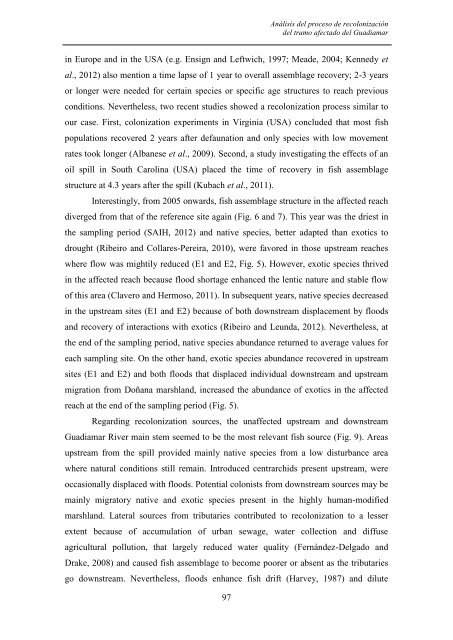las comunidades de peces del río guadiamar y el accidente minero ...
las comunidades de peces del río guadiamar y el accidente minero ...
las comunidades de peces del río guadiamar y el accidente minero ...
Create successful ePaper yourself
Turn your PDF publications into a flip-book with our unique Google optimized e-Paper software.
Análisis <strong>de</strong>l proceso <strong>de</strong> recolonización<br />
<strong>de</strong>l tramo afectado <strong>de</strong>l Guadiamar<br />
in Europe and in the USA (e.g. Ensign and Leftwich, 1997; Mea<strong>de</strong>, 2004; Kennedy et<br />
al., 2012) also mention a time lapse of 1 year to overall assemblage recovery; 2-3 years<br />
or longer were nee<strong>de</strong>d for certain species or specific age structures to reach previous<br />
conditions. Neverth<strong>el</strong>ess, two recent studies showed a recolonization process similar to<br />
our case. First, colonization experiments in Virginia (USA) conclu<strong>de</strong>d that most fish<br />
populations recovered 2 years after <strong>de</strong>faunation and only species with low movement<br />
rates took longer (Albanese et al., 2009). Second, a study investigating the effects of an<br />
oil spill in South Carolina (USA) placed the time of recovery in fish assemblage<br />
structure at 4.3 years after the spill (Kubach et al., 2011).<br />
Interestingly, from 2005 onwards, fish assemblage structure in the affected reach<br />
diverged from that of the reference site again (Fig. 6 and 7). This year was the driest in<br />
the sampling period (SAIH, 2012) and native species, better adapted than exotics to<br />
drought (Ribeiro and Collares-Pereira, 2010), were favored in those upstream reaches<br />
where flow was mightily reduced (E1 and E2, Fig. 5). However, exotic species thrived<br />
in the affected reach because flood shortage enhanced the lentic nature and stable flow<br />
of this area (Clavero and Hermoso, 2011). In subsequent years, native species <strong>de</strong>creased<br />
in the upstream sites (E1 and E2) because of both downstream displacement by floods<br />
and recovery of interactions with exotics (Ribeiro and Leunda, 2012). Neverth<strong>el</strong>ess, at<br />
the end of the sampling period, native species abundance returned to average values for<br />
each sampling site. On the other hand, exotic species abundance recovered in upstream<br />
sites (E1 and E2) and both floods that displaced individual downstream and upstream<br />
migration from Doñana marshland, increased the abundance of exotics in the affected<br />
reach at the end of the sampling period (Fig. 5).<br />
Regarding recolonization sources, the unaffected upstream and downstream<br />
Guadiamar River main stem seemed to be the most r<strong>el</strong>evant fish source (Fig. 9). Areas<br />
upstream from the spill provi<strong>de</strong>d mainly native species from a low disturbance area<br />
where natural conditions still remain. Introduced centrarchids present upstream, were<br />
occasionally displaced with floods. Potential colonists from downstream sources may be<br />
mainly migratory native and exotic species present in the highly human-modified<br />
marshland. Lateral sources from tributaries contributed to recolonization to a lesser<br />
extent because of accumulation of urban sewage, water collection and diffuse<br />
agricultural pollution, that larg<strong>el</strong>y reduced water quality (Fernán<strong>de</strong>z-D<strong>el</strong>gado and<br />
Drake, 2008) and caused fish assemblage to become poorer or absent as the tributaries<br />
go downstream. Neverth<strong>el</strong>ess, floods enhance fish drift (Harvey, 1987) and dilute<br />
97

















